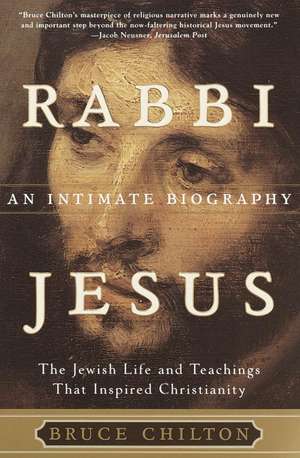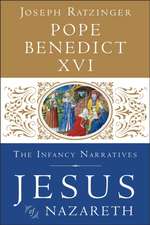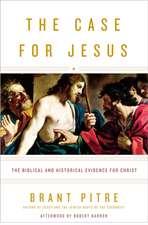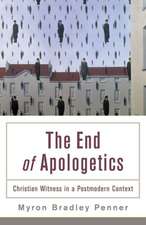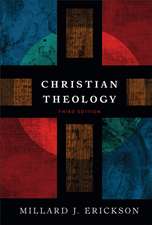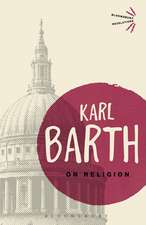Rabbi Jesus: An Intimate Biography
Autor Bruce Chilton, Chilton Bruceen Limba Engleză Paperback – 31 ian 2002
Drawing on recent archaeological findings and new translations and interpretations of ancient texts, Chilton discusses in enlightening detail the philosophical and psychological foundations of Jesus’ ideas and beliefs. His in-depth investigation also provides evidence that contradicts long-held beliefs about Jesus and the movement he led. Chilton shows, for example, that the High Priest Caiaphas, as well as Pontius Pilate, played a central role in Jesus’ execution. It is, however, Chilton’s description of Jesus’ role as a rabbi, or "master," of Jewish oral traditions, as a teacher of the Cabala, and as a practitioner of a Galilean form of Judaism that emphasized direct communication with God that casts an entirely new light on the origins of Christianity.
Seamlessly merging history and biography, this penetrating, highly readable book uncovers truths lost to the passage of time and reveals a new Jesus for the new millennium.
Preț: 100.83 lei
Nou
Puncte Express: 151
Preț estimativ în valută:
19.30€ • 19.99$ • 16.10£
19.30€ • 19.99$ • 16.10£
Carte disponibilă
Livrare economică 01-15 martie
Preluare comenzi: 021 569.72.76
Specificații
ISBN-13: 9780385497930
ISBN-10: 0385497938
Pagini: 354
Dimensiuni: 140 x 208 x 20 mm
Greutate: 0.34 kg
Ediția:Image Books.
Editura: IMAGE
ISBN-10: 0385497938
Pagini: 354
Dimensiuni: 140 x 208 x 20 mm
Greutate: 0.34 kg
Ediția:Image Books.
Editura: IMAGE
Notă biografică
BRUCE CHILTON is the Bernard Iddings Bell Professor of Religion at Bard College in Annandale-on-Hudson and priest at the Free Church of Saint John in Barrytown, New York. He is the author of many scholarly articles and books, including Redeeming Time and A Galilean Rabbi and His Bible.
Extras
One
A Mamzer from Nazareth
Jesus' life in Judaism opened with his berith, the ritual of circumcision mandated by the Torah for every male child of Israel. As required in the book of Genesis (17:9-14), he was eight days old when the foreskin of his penis was cut. In the small, poor village where Jesus was born, communal rituals often occurred in the open village center, near the wine press, olive vats, and pottery kiln. Circumcision, however, especially during cold weather, required shelter to help ward off the infant's shock, which is why I think Jesus' berith would have taken place in his family's courtyard.
Guests gathered for the ceremony, probably in the early morning, when blood clots more easily. "Shelama!" they greeted each other. Shelama is the Aramaic equivalent of shalom, "peace," in Hebrew. Aramaic, not Hebrew, was the language most commonly used by the Jews of Galilee, Judea, and Syria at the dawn of the Common Era. Standing in relation to Hebrew something like Italian does to French, Aramaic is a Semitic tongue, one of the world's oldest continuously spoken languages. Once as widespread in the Near East as Arabic is today, it is now nearly extinct, except as kept alive by a few native speakers in Iran, Iraq, Syria, Turkey, and Azerbaijan.
The shelama greeting in the Galileans' own tongue celebrated Jewish survival in a land under foreign dominance by reminding Jews of God's enduring covenant with Abraham--the very covenant put into practice in Jesus' circumcision. Even his name in Aramaic, Yeshua, conjured up the memory of Joshua, the heroic successor of Moses. Those gathered in the little village must have been keenly aware that they were a tiny, powerless group in an occupied province of the Roman Empire whose Jewish identity was under siege.
Galilean Jews were indentured but not defeated. They burned with pride in a living memory of themselves as the people called Israel, descended from the patriarch Jacob, grandson of Abraham. They had tilled this soil and called this land theirs for more than a thousand years, fighting war after war, enduring defeat, genocide, and exile at the hands of foreigners, later suffering the prejudice and dominance of the wealthier Jews of Judea to the south. Their identity as Jews was bound up in the land and the covenant that made the land theirs. The covenant was their last defense against Rome, a cultural fortress that stood long after the political and military institutions of Israel had failed.
Their understanding of the covenant came not from the written Torah and Prophets in Hebrew, which few could read, but from their oral targum (Aramaic for "translation"). A targum was more than a verbatim translation of the Hebrew text: whole paragraphs were added and long sections loosely paraphrased by the meturgeman, a "translator" who handed on the local tradition of rendering Scripture. (Just as a local rabbi designed ethical norms for living the Torah, a meturgeman memorized and recited the oral Scripture). These renderings vivified the Torah and the Prophets in a visionary language detailing Israel's coming supremacy over other nations and emphasizing the promises God had made to an oppressed, indentured people. One day, these Scriptural renderings promised, God's Kingdom (Malkhuta) would supersede every other form of rule. That was the fervent hope of the Galilean Jews who filled the courtyard to witness Jesus' circumcision; the cutting of the infant's foreskin brought them one small step closer to the Kingdom where God would rule, not Rome. God himself would reestablish the glory of Israel and vindicate the chosen people.
Mary and Joseph were seeking their own vindication as they held the infant ready to have the covenant with Israel marked in his flesh. Jesus had been conceived before they were married, and doubts about his paternity were the result: "His mother Miriam was contracted in marriage to Yosef; before they were together she was found pregnant from holy spirit" (Matthew 1:18, in my own translation). His parents must have hoped the circumcision would reduce the stigma of his birth.
Controversy about whether God, Joseph, or some other man impregnated Mary has been intense and long-standing. Churches have viewed departure from established doctrine in these matters as heresy, and the penalties for such heresy have sometimes been extreme and violent. Even today, there are instances of Catholic and Protestant clergy being silenced or excommunicated for denying Mary's virginity, even in the Anglican church of which I am a priest. Perhaps that is why scholarship has shied away from resolving crucial questions of fact about the nativity. Although we can never recover all the details of Jesus' birth, I do think it is possible to construct a credible overall picture.
The charge that he was illicitly conceived plagued Jesus all his life. Even far from his home, during disputes in Jerusalem after he had become a famous teacher, Jesus was mocked for being born as the result of "fornication" (John 8:41). The people of his own village called him "Mary's son," not Joseph's (Mark 6:3). Scholarship should explain both why Jesus was insulted for his allegedly irregular birth and why the legend developed that he was born of a virgin. By examining the ancient Jewish commitment to the maintenance of family lineage--which was the cultural context of Jesus' birth--we can explain the charge of illicit conception and discover one of the most profound influences on Jesus' personal development.
Miriam, Mary as we now know her, was some thirteen years old--the age Jewish maidens of that time married--when Jesus' father, the widower Joseph, came to her village of Nazareth, in all likelihood to repair the house of her parents. Joseph was a journeyman from nearby Bethlehem, a roofer, stonemason, and rough carpenter. It makes sense that he met Mary in the early spring. Although heavy rains made travel difficult then, he could ply his trade before he was needed at home to tend his fields of wheat and barley. Legend--bowing to the imperial Roman feast of Sol Invictus, the invincible sun, which was widely celebrated during the third century c.e.--has Jesus born on December 25. But reckoned from his parents' likely time of meeting, his birth was earlier, probably in the late autumn.
The attraction between Joseph and Mary must have been immediate; they broke with custom and slept together soon after meeting and well before their marriage was publicly recognized. Mary's family had agreed to a contract of marriage with Joseph, but the couple was not yet living together when her pregnancy became obvious. The wording of the New Testament itself, although written many years after the events and richly laced with legends concerning Jesus' birth, attests to this simple fact in Matthew 1:18: before they resided together Mary was obviously pregnant.
That precise statement in Matthew's Gospel explains why, over time, Jesus was considered to be born of fornication by some and the product of a miraculous birth by others. The early pregnancy touched off vicious rumors in Mary's village of Nazareth: perhaps Joseph was not really the child's father. So, for the birth, Joseph had brought Mary to Bethlehem of Galilee, where he had lived with his first wife, to shield her from Nazareth's wagging tongues.
Christmas cards, of course, make Bethlehem of Judea (near Jerusalem) the place of Jesus' birth, instead of the far more logical Bethlehem of Galilee. That is because Matthew's Gospel (2:1-6), written around the year 80 c.e. in Syrian Damascus, relates the nativity to a prediction in the book of the prophet Micah (5:2) regarding the coming of the Messiah from Judean Bethlehem. Matthew fills in details of Jesus' birth by declaring that the events "fulfilled" texts from the Scriptures of Israel. Another example of Messianic fulfillment is the biblical text "Look, a maiden shall conceive," culled from the book of Isaiah (7:14) and applied by Matthew to Mary's conception of Jesus before she was actually living with Joseph (Matthew 1:22-23).
Christians later used Matthew to support their claim that Mary was a biological virgin at the time of Jesus' birth. In one influential text, the Protoevangelium of James (19-20), an assisting midwife, Salome, reaches into Mary's vagina after Jesus' birth and feels Mary's intact hymen. Generations of scholars have been frustrated by the way such legends have clouded how their students and the general public read the New Testament. (A recent study published by the Scripps Howard News Service and the E. W. Scripps School of Journalism at Ohio University found that a staggering 62 percent of Americans believe in the virgin birth.) In their frustration, many professors have dismissed Matthew's version of the nativity as mere legend, and have rejected its historical value.
I can understand my colleagues' frustration--but Matthew's Gospel is not to blame for the embellishments that came after it. The famous text in Greek, "a maiden (parthenos) shall conceive," became "a virgin shall conceive" when Matthew was translated into Latin during the second century, and the change of a word fed the development of the legend of Jesus' miraculous birth. Both almah in Isaiah's Hebrew and parthenos in Matthew's Greek (and come to that, even the Latin virgo) refer to a "maiden" rather than a biological "virgin."
Matthew accurately presented some details of Jesus' birth, although they have been clouded by polemics. Two persistent strands emerged from Matthew in ancient scholarship: Mary was either Christianity's immaculate virgin or the Talmud's common whore who had slept with a Roman soldier (in the Babylonian Talmud, see Sanhedrin 67a). Rather than take sides in this stark controversy, modern scholarship has left the circumstances of Jesus' birth in a haze of doubt. In addition, because they have distrusted Matthew's nativity, many scholars have ruled out Bethlehem as Jesus' birthplace. Recent discoveries show that is a mistake.
Bethlehem in Hebrew means "house of bread," a common name for settlements with mills capable of producing fine flour, rather than the coarse grade most Israelites used for their daily needs. In 1975, amid the musty, damp, and badly lit back shelves of the University Library in Cambridge, I first learned of a Galilean Bethlehem, near Nazareth, from an obscure study of the Talmud published during the nineteenth century. I was surprised at the dearth of discussion of this place in New Testament studies as the possible site of Jesus' birth, especially since a northern Bethlehem is mentioned in the Hebrew Bible (Joshua 19:15).
Conscious of how easily a new idea can be rejected, I was intrigued but wary. The Talmud was composed centuries after Jesus lived and the book of Joshua centuries beforehand, so one cannot assume they accurately reflect Galilee's geography in his time. I appended my findings to my Ph.D. thesis (although some of my professors were bemused that I used the Talmud to understand the Gospels) and let the matter rest. Now, however, archeological excavations show that Bethlehem in Galilee is a first-century site just seven miles from Nazareth, so my former reserve can be put aside. There is good reason to surmise that the Bethlehem to which Matthew refers was in Galilee.
We can envisage Jesus' berith on the basis of the excavations of Bethlehem and Nazareth, together with historical information from ancient sources such as the Mishnah (composed during the second century c.e., but incorporating earlier oral sources). The weather at that time of year in Galilee was probably cool and clear, and guests wore rough woolen cloaks over their basic flax tunics against the chill. The landscape around Bethlehem was similar to Nazareth's, although somewhat rockier. Terraced fields climbed up the hillsides. There were orchards of almonds, pomegranates, and dates, and trellised vineyards of red grapes that made a ruddy new wine at harvest time--a sweet, heady drink that would have been mixed with oil to dress Jesus' wound, dribbled into his mouth to cut his pain, and served to guests after the ceremony.
Mary handed her firstborn to Joseph. The ritual performance of berith was a male preserve. The couple shared one of the two or three small mud and stone houses, with dirt floors and low wooden beds, that surrounded a large, central courtyard. Joseph carried Jesus into the courtyard, reenacting Abraham's willingness to circumcise Isaac on the eighth day and even, if necessary, to sacrifice his son (see Genesis 21:4; 22:1-18).
A village dignitary would have pulled Jesus' flesh tight and cut quickly, then carried the unclean foreskin away on a broken pottery shard and disposed of it in an abandoned spot outside the village. Circumcision was performed by a respected and physically competent elder. He had to cut accurately, tear the foreskin, suck the wound clean (as the Mishnah prescribes in Shabbath 19:2), and apply a dressing of wine and olive oil with balm (tapped from a terebinth tree) and cumin. The procedure had not yet been assigned to a professional mohel, or circumciser, as in later Rabbinic tradition.
The privilege of circumcising made the elder who touched the foreskin unclean. (Foreskin was a source of contagious impurity for the various peoples, Semitic and not, who practiced circumcision.) Rather than join the celebration after the cutting, the dignitary ritually bathed to wash away the uncleanness, and removed himself temporarily from the community.
Blood of childbirth, blood of berith, blood of animal sacrifice, blood of the ancestral convenant made a Jew a Jew. Blood was the most holy thing in Israel's system of purity. It was life itself, coursing in their veins as alive, mysterious, and potent as the streams that flowed from the mountains of Galilee or the wind that rushed over the fields and villages at night. Galilean Jews were not only connected to the divine in their minds, they were bound by blood to God. The ritual bleeding of an animal prior to consuming it, ritually causing a male infant to bleed at his berith, the ritual of secluding women after childbirth and menstruation--all reflect the root wisdom that blood belongs to God alone (see Leviticus 17:10-11).
Moses had commanded Israel in God's name to eat no animal's blood; blood was either to be sacrificed to God in the Temple in Jerusalem or poured into the ground (Deuteronomy 12:23-27). Blood was forbidden to Israelites because it was too holy, not because it was inherently impure in the way a foreskin was. In ancient Judaism, blood and the parts of beasts to be offered in sacrifice are forbidden because they belong to the divine alone, not to human beings. But other things, impure beasts and carcasses, are not fit for consumption or contact (as in the case of foreskins), whether human (Israelite) or divine. The laws of cleanness in Leviticus (chapters 11-26) were Israel's means of producing sacrifices that were acceptable to God, apart from which the land itself could not be retained. Leviticus warns that the former inhabitants of the land had failed to keep the rules of purity and for that reason were expelled; Israel might suffer the same fate (Leviticus 18:24-30). The land, in Leviticus, is not for Israel; Israel is for the service of God in his land.
A Mamzer from Nazareth
Jesus' life in Judaism opened with his berith, the ritual of circumcision mandated by the Torah for every male child of Israel. As required in the book of Genesis (17:9-14), he was eight days old when the foreskin of his penis was cut. In the small, poor village where Jesus was born, communal rituals often occurred in the open village center, near the wine press, olive vats, and pottery kiln. Circumcision, however, especially during cold weather, required shelter to help ward off the infant's shock, which is why I think Jesus' berith would have taken place in his family's courtyard.
Guests gathered for the ceremony, probably in the early morning, when blood clots more easily. "Shelama!" they greeted each other. Shelama is the Aramaic equivalent of shalom, "peace," in Hebrew. Aramaic, not Hebrew, was the language most commonly used by the Jews of Galilee, Judea, and Syria at the dawn of the Common Era. Standing in relation to Hebrew something like Italian does to French, Aramaic is a Semitic tongue, one of the world's oldest continuously spoken languages. Once as widespread in the Near East as Arabic is today, it is now nearly extinct, except as kept alive by a few native speakers in Iran, Iraq, Syria, Turkey, and Azerbaijan.
The shelama greeting in the Galileans' own tongue celebrated Jewish survival in a land under foreign dominance by reminding Jews of God's enduring covenant with Abraham--the very covenant put into practice in Jesus' circumcision. Even his name in Aramaic, Yeshua, conjured up the memory of Joshua, the heroic successor of Moses. Those gathered in the little village must have been keenly aware that they were a tiny, powerless group in an occupied province of the Roman Empire whose Jewish identity was under siege.
Galilean Jews were indentured but not defeated. They burned with pride in a living memory of themselves as the people called Israel, descended from the patriarch Jacob, grandson of Abraham. They had tilled this soil and called this land theirs for more than a thousand years, fighting war after war, enduring defeat, genocide, and exile at the hands of foreigners, later suffering the prejudice and dominance of the wealthier Jews of Judea to the south. Their identity as Jews was bound up in the land and the covenant that made the land theirs. The covenant was their last defense against Rome, a cultural fortress that stood long after the political and military institutions of Israel had failed.
Their understanding of the covenant came not from the written Torah and Prophets in Hebrew, which few could read, but from their oral targum (Aramaic for "translation"). A targum was more than a verbatim translation of the Hebrew text: whole paragraphs were added and long sections loosely paraphrased by the meturgeman, a "translator" who handed on the local tradition of rendering Scripture. (Just as a local rabbi designed ethical norms for living the Torah, a meturgeman memorized and recited the oral Scripture). These renderings vivified the Torah and the Prophets in a visionary language detailing Israel's coming supremacy over other nations and emphasizing the promises God had made to an oppressed, indentured people. One day, these Scriptural renderings promised, God's Kingdom (Malkhuta) would supersede every other form of rule. That was the fervent hope of the Galilean Jews who filled the courtyard to witness Jesus' circumcision; the cutting of the infant's foreskin brought them one small step closer to the Kingdom where God would rule, not Rome. God himself would reestablish the glory of Israel and vindicate the chosen people.
Mary and Joseph were seeking their own vindication as they held the infant ready to have the covenant with Israel marked in his flesh. Jesus had been conceived before they were married, and doubts about his paternity were the result: "His mother Miriam was contracted in marriage to Yosef; before they were together she was found pregnant from holy spirit" (Matthew 1:18, in my own translation). His parents must have hoped the circumcision would reduce the stigma of his birth.
Controversy about whether God, Joseph, or some other man impregnated Mary has been intense and long-standing. Churches have viewed departure from established doctrine in these matters as heresy, and the penalties for such heresy have sometimes been extreme and violent. Even today, there are instances of Catholic and Protestant clergy being silenced or excommunicated for denying Mary's virginity, even in the Anglican church of which I am a priest. Perhaps that is why scholarship has shied away from resolving crucial questions of fact about the nativity. Although we can never recover all the details of Jesus' birth, I do think it is possible to construct a credible overall picture.
The charge that he was illicitly conceived plagued Jesus all his life. Even far from his home, during disputes in Jerusalem after he had become a famous teacher, Jesus was mocked for being born as the result of "fornication" (John 8:41). The people of his own village called him "Mary's son," not Joseph's (Mark 6:3). Scholarship should explain both why Jesus was insulted for his allegedly irregular birth and why the legend developed that he was born of a virgin. By examining the ancient Jewish commitment to the maintenance of family lineage--which was the cultural context of Jesus' birth--we can explain the charge of illicit conception and discover one of the most profound influences on Jesus' personal development.
Miriam, Mary as we now know her, was some thirteen years old--the age Jewish maidens of that time married--when Jesus' father, the widower Joseph, came to her village of Nazareth, in all likelihood to repair the house of her parents. Joseph was a journeyman from nearby Bethlehem, a roofer, stonemason, and rough carpenter. It makes sense that he met Mary in the early spring. Although heavy rains made travel difficult then, he could ply his trade before he was needed at home to tend his fields of wheat and barley. Legend--bowing to the imperial Roman feast of Sol Invictus, the invincible sun, which was widely celebrated during the third century c.e.--has Jesus born on December 25. But reckoned from his parents' likely time of meeting, his birth was earlier, probably in the late autumn.
The attraction between Joseph and Mary must have been immediate; they broke with custom and slept together soon after meeting and well before their marriage was publicly recognized. Mary's family had agreed to a contract of marriage with Joseph, but the couple was not yet living together when her pregnancy became obvious. The wording of the New Testament itself, although written many years after the events and richly laced with legends concerning Jesus' birth, attests to this simple fact in Matthew 1:18: before they resided together Mary was obviously pregnant.
That precise statement in Matthew's Gospel explains why, over time, Jesus was considered to be born of fornication by some and the product of a miraculous birth by others. The early pregnancy touched off vicious rumors in Mary's village of Nazareth: perhaps Joseph was not really the child's father. So, for the birth, Joseph had brought Mary to Bethlehem of Galilee, where he had lived with his first wife, to shield her from Nazareth's wagging tongues.
Christmas cards, of course, make Bethlehem of Judea (near Jerusalem) the place of Jesus' birth, instead of the far more logical Bethlehem of Galilee. That is because Matthew's Gospel (2:1-6), written around the year 80 c.e. in Syrian Damascus, relates the nativity to a prediction in the book of the prophet Micah (5:2) regarding the coming of the Messiah from Judean Bethlehem. Matthew fills in details of Jesus' birth by declaring that the events "fulfilled" texts from the Scriptures of Israel. Another example of Messianic fulfillment is the biblical text "Look, a maiden shall conceive," culled from the book of Isaiah (7:14) and applied by Matthew to Mary's conception of Jesus before she was actually living with Joseph (Matthew 1:22-23).
Christians later used Matthew to support their claim that Mary was a biological virgin at the time of Jesus' birth. In one influential text, the Protoevangelium of James (19-20), an assisting midwife, Salome, reaches into Mary's vagina after Jesus' birth and feels Mary's intact hymen. Generations of scholars have been frustrated by the way such legends have clouded how their students and the general public read the New Testament. (A recent study published by the Scripps Howard News Service and the E. W. Scripps School of Journalism at Ohio University found that a staggering 62 percent of Americans believe in the virgin birth.) In their frustration, many professors have dismissed Matthew's version of the nativity as mere legend, and have rejected its historical value.
I can understand my colleagues' frustration--but Matthew's Gospel is not to blame for the embellishments that came after it. The famous text in Greek, "a maiden (parthenos) shall conceive," became "a virgin shall conceive" when Matthew was translated into Latin during the second century, and the change of a word fed the development of the legend of Jesus' miraculous birth. Both almah in Isaiah's Hebrew and parthenos in Matthew's Greek (and come to that, even the Latin virgo) refer to a "maiden" rather than a biological "virgin."
Matthew accurately presented some details of Jesus' birth, although they have been clouded by polemics. Two persistent strands emerged from Matthew in ancient scholarship: Mary was either Christianity's immaculate virgin or the Talmud's common whore who had slept with a Roman soldier (in the Babylonian Talmud, see Sanhedrin 67a). Rather than take sides in this stark controversy, modern scholarship has left the circumstances of Jesus' birth in a haze of doubt. In addition, because they have distrusted Matthew's nativity, many scholars have ruled out Bethlehem as Jesus' birthplace. Recent discoveries show that is a mistake.
Bethlehem in Hebrew means "house of bread," a common name for settlements with mills capable of producing fine flour, rather than the coarse grade most Israelites used for their daily needs. In 1975, amid the musty, damp, and badly lit back shelves of the University Library in Cambridge, I first learned of a Galilean Bethlehem, near Nazareth, from an obscure study of the Talmud published during the nineteenth century. I was surprised at the dearth of discussion of this place in New Testament studies as the possible site of Jesus' birth, especially since a northern Bethlehem is mentioned in the Hebrew Bible (Joshua 19:15).
Conscious of how easily a new idea can be rejected, I was intrigued but wary. The Talmud was composed centuries after Jesus lived and the book of Joshua centuries beforehand, so one cannot assume they accurately reflect Galilee's geography in his time. I appended my findings to my Ph.D. thesis (although some of my professors were bemused that I used the Talmud to understand the Gospels) and let the matter rest. Now, however, archeological excavations show that Bethlehem in Galilee is a first-century site just seven miles from Nazareth, so my former reserve can be put aside. There is good reason to surmise that the Bethlehem to which Matthew refers was in Galilee.
We can envisage Jesus' berith on the basis of the excavations of Bethlehem and Nazareth, together with historical information from ancient sources such as the Mishnah (composed during the second century c.e., but incorporating earlier oral sources). The weather at that time of year in Galilee was probably cool and clear, and guests wore rough woolen cloaks over their basic flax tunics against the chill. The landscape around Bethlehem was similar to Nazareth's, although somewhat rockier. Terraced fields climbed up the hillsides. There were orchards of almonds, pomegranates, and dates, and trellised vineyards of red grapes that made a ruddy new wine at harvest time--a sweet, heady drink that would have been mixed with oil to dress Jesus' wound, dribbled into his mouth to cut his pain, and served to guests after the ceremony.
Mary handed her firstborn to Joseph. The ritual performance of berith was a male preserve. The couple shared one of the two or three small mud and stone houses, with dirt floors and low wooden beds, that surrounded a large, central courtyard. Joseph carried Jesus into the courtyard, reenacting Abraham's willingness to circumcise Isaac on the eighth day and even, if necessary, to sacrifice his son (see Genesis 21:4; 22:1-18).
A village dignitary would have pulled Jesus' flesh tight and cut quickly, then carried the unclean foreskin away on a broken pottery shard and disposed of it in an abandoned spot outside the village. Circumcision was performed by a respected and physically competent elder. He had to cut accurately, tear the foreskin, suck the wound clean (as the Mishnah prescribes in Shabbath 19:2), and apply a dressing of wine and olive oil with balm (tapped from a terebinth tree) and cumin. The procedure had not yet been assigned to a professional mohel, or circumciser, as in later Rabbinic tradition.
The privilege of circumcising made the elder who touched the foreskin unclean. (Foreskin was a source of contagious impurity for the various peoples, Semitic and not, who practiced circumcision.) Rather than join the celebration after the cutting, the dignitary ritually bathed to wash away the uncleanness, and removed himself temporarily from the community.
Blood of childbirth, blood of berith, blood of animal sacrifice, blood of the ancestral convenant made a Jew a Jew. Blood was the most holy thing in Israel's system of purity. It was life itself, coursing in their veins as alive, mysterious, and potent as the streams that flowed from the mountains of Galilee or the wind that rushed over the fields and villages at night. Galilean Jews were not only connected to the divine in their minds, they were bound by blood to God. The ritual bleeding of an animal prior to consuming it, ritually causing a male infant to bleed at his berith, the ritual of secluding women after childbirth and menstruation--all reflect the root wisdom that blood belongs to God alone (see Leviticus 17:10-11).
Moses had commanded Israel in God's name to eat no animal's blood; blood was either to be sacrificed to God in the Temple in Jerusalem or poured into the ground (Deuteronomy 12:23-27). Blood was forbidden to Israelites because it was too holy, not because it was inherently impure in the way a foreskin was. In ancient Judaism, blood and the parts of beasts to be offered in sacrifice are forbidden because they belong to the divine alone, not to human beings. But other things, impure beasts and carcasses, are not fit for consumption or contact (as in the case of foreskins), whether human (Israelite) or divine. The laws of cleanness in Leviticus (chapters 11-26) were Israel's means of producing sacrifices that were acceptable to God, apart from which the land itself could not be retained. Leviticus warns that the former inhabitants of the land had failed to keep the rules of purity and for that reason were expelled; Israel might suffer the same fate (Leviticus 18:24-30). The land, in Leviticus, is not for Israel; Israel is for the service of God in his land.
Recenzii
"Open this book and see Jesus as you’ve never seen him . . . This is one heck of a good read. And it left me feeling better than ever about the Jesus we try to serve and follow." –National Catholic Reporter
"Engaging and lively . . . Chilton has done an admirable job of taking us into Jesus’ world and witnessing the life of one of history’s most important figures." –Charlotte Observer
"Bruce Chilton, an Anglican priest and religion professor, has written a readable and compelling profile of Jesus and the culture and times in which he lived. Rabbi Jesus is a scholarly pursuit that . . . reads more like a novel. The biography flows with the fluidity of an adventure tale, rich in characters, texture, and detail." –Herald-Sun (Durham, N.C.)
"Engaging and lively . . . Chilton has done an admirable job of taking us into Jesus’ world and witnessing the life of one of history’s most important figures." –Charlotte Observer
"Bruce Chilton, an Anglican priest and religion professor, has written a readable and compelling profile of Jesus and the culture and times in which he lived. Rabbi Jesus is a scholarly pursuit that . . . reads more like a novel. The biography flows with the fluidity of an adventure tale, rich in characters, texture, and detail." –Herald-Sun (Durham, N.C.)
Descriere
Seamlessly merging history and biography, noted Biblical scholar Bruce Chilton places Jesus within the context of his times to present a fresh, historically accurate, and revolutionary examination of the man who founded Christianity. Photos & illustrations.
